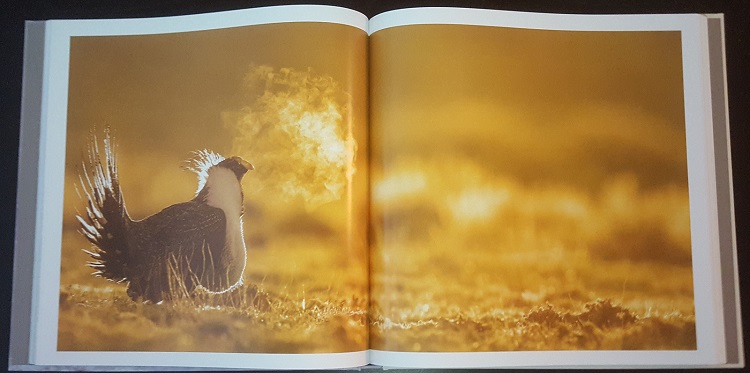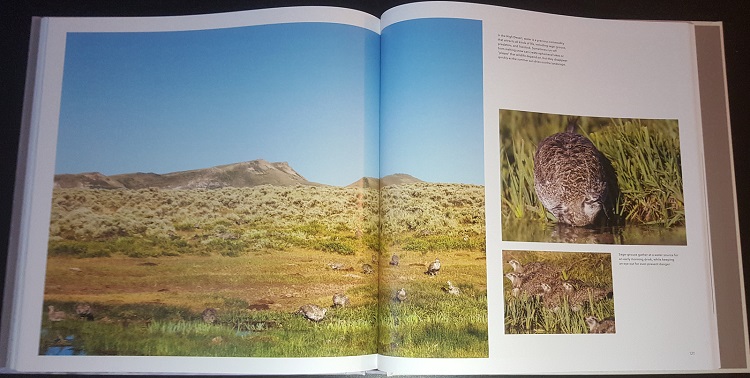Reviewed by Grant McCreary on May 12th, 2018.
It is a most unlikely sight. A dozen or more large birds, just standing around in an open area. Tails held up with fanned-out spikes, yellow sacs protruding out of…what is that white stuff, exactly? And then there’s that weird popping noise. A displaying group of sage-grouse is an experience. But as cool as that is, these birds are so much more than an odd spectacle. With the photography of Noppadol Paothong and words of Kathy Love, Sage Grouse: Icon of the West illuminates the lives of these special birds.
Paothong’s first book, the wonderful Save the Last Dance: A Story of North American Grassland Grouse, covers the lekking grouse and prairie-chickens of North America. In this follow-up, he narrows the focus to the sage-grouse, primarily the Greater Sage-Grouse. The other sage-grouse, the relatively recently discovered Gunnison’s, is profiled in a two-page spread, but otherwise this is the Greater’s book. But, as the widespread “icon of the west”, that’s understandable.
Any discussion of this book has to begin with its photographs. You will not find a better collection of sage-grouse images anywhere. As birders, we’re most familiar with sage-grouse on their lek, with the males gathered thereon to perform one of the most bizarre-looking, and -sounding, displays in nature. You will see plenty of such scenes in Sage Grouse. Paothong has captured all the action, from just about every angle and in every condition. Moreover, he has done so artistically and imaginatively. These photos are, simply, beautiful.
But the thing I love most about them is the variety. Some of my favorites are unconventional views, such as the back of a head or a displaying male from the rear – both are surprisingly interesting. Females and young birds get almost as much attention as the males. Many of the photos don’t even include the titular bird; landscapes, other animals and birds, even people are also featured.
As with the photos, the text covers the entire life-cycle of the sage-grouse. While it provides a good overview of the species, this is not intended to be a detailed biography of the species. Instead, like with the photos, the writer places the sage-grouse in a larger context, as befits its status as an indicator species of the “Sagebrush Sea”. This habitat is often overlooked, so it’s nice to see it get some loving attention.
I wish this book could just stick with beautiful pictures and an exploration of this bird’s amazing behavior and biology. But it also has to deal with conservation. Sage-grouse populations “declined by 56 percent between 2007 and 2013,” and they are further endangered by ever-increasing habitat destruction from energy and resource extraction. And, of course, there is climate change. But it is not without hope. Love details the issues, but also reports on ranchers working together with conservationists to protect the sage-grouse, partly because they want to forestall the need to list the bird under the Endangered Species Act, but also because they love the land.
Recommendation
Love of the land. An appreciate for the sage-grouse. This is what will save it. And this is what Sage Grouse: Icon of the West provides. That, and the best collection of photographs of the sage-grouse and its environment that you will find anywhere.
Disclosure: I get a small commission for purchases made through links in this post.
Buy from NHBS
(based in the U.K.)
Disclosure: The item reviewed here was a complementary review copy provided by the author. But the opinion expressed here is my own, it has not been influenced in any way.







Comment